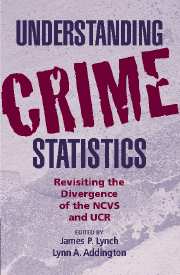Book contents
- Frontmatter
- Contents
- Acknowledgments
- Contributor Biographies
- INTRODUCTION
- OVERVIEW OF THE TWO NATIONAL MEASURES OF U.S. CRIME
- DEFINING DIVERGENCE AND CONVERGENCE
- SOURCES OF DIVERGENCE IN THE NCVS
- SOURCES OF DIVERGENCE IN THE UCR
- 8 Using NIBRS to Study Methodological Sources of Divergence Between the UCR and NCVS
- 9 Explaining the Divergence Between UCR and NCVS Aggravated Assault Trends
- 10 Missing UCR Data and Divergence of the NCVS and UCR Trends
- CONCLUSION
- Index
- CAMBRIDGE STUDIES IN CRIMINOLOGY
- References
8 - Using NIBRS to Study Methodological Sources of Divergence Between the UCR and NCVS
Published online by Cambridge University Press: 23 December 2009
- Frontmatter
- Contents
- Acknowledgments
- Contributor Biographies
- INTRODUCTION
- OVERVIEW OF THE TWO NATIONAL MEASURES OF U.S. CRIME
- DEFINING DIVERGENCE AND CONVERGENCE
- SOURCES OF DIVERGENCE IN THE NCVS
- SOURCES OF DIVERGENCE IN THE UCR
- 8 Using NIBRS to Study Methodological Sources of Divergence Between the UCR and NCVS
- 9 Explaining the Divergence Between UCR and NCVS Aggravated Assault Trends
- 10 Missing UCR Data and Divergence of the NCVS and UCR Trends
- CONCLUSION
- Index
- CAMBRIDGE STUDIES IN CRIMINOLOGY
- References
Summary
INTRODUCTION
This chapter examines the contribution of methodological differences to divergence when comparing crimes reported to the Uniform Crime Reporting System (UCR) and National Crime Victimization Survey (NCVS). This study focuses on differences in population coverage and crime counting rules between the two series. Population coverage differences concern the UCR's inclusion of commercial and nonindividual victims and its inclusion of individual victims of all ages. Crime counting rule variations include the application of the UCR's Hierarchy Rule and the UCR's consideration of robberies as property offenses as opposed to crimes against a person. Understanding the extent to which these differences play a role in divergence between the UCR and NCVS is important to better ascertain whether this divergence is an artifact of methodologies or the result of substantive issues.
Although the methodological differences between the UCR and NCVS are easy to identify, they are much more difficult to quantify. As a result, little is known about the extent, if any, to which these differences contribute to divergence. Researchers have attempted to adjust each series to account for these differences (see Chapter 4, this volume, for a summary). These adjustments, however, are only approximations. The UCR's traditional summary reporting system does not collect the incident details necessary to measure these differences accurately and inform about potential sources of divergence. Currently the UCR is in the process of a substantial conversion from its aggregate system (“the summary system”) to the National Incident-Based Reporting System (NIBRS), which, as its name suggests, collects incident-level data.
- Type
- Chapter
- Information
- Understanding Crime StatisticsRevisiting the Divergence of the NCVS and the UCR, pp. 225 - 250Publisher: Cambridge University PressPrint publication year: 2006
References
- 3
- Cited by

